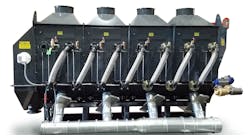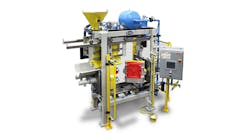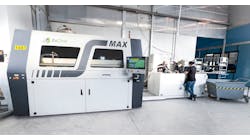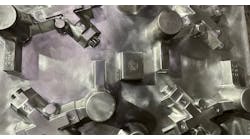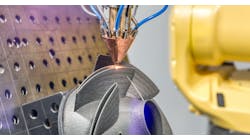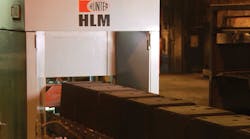Many technologies are described as a ‘breakthrough’ when they first appear, but in fact the market determines the truth of such claims. Once customers have accepted a technology, the inventors and developers have their chance to prove the significance of the work, by keeping the customers impressed, and by advancing the capabilities of their technology.
When it arrived on the metalcasting scene in 2013, Hunter Foundry Machinery’s HLM Series molding machine was recognized as the new phase of matchplate technology: it incorporated magnetically coupled rodless cylinders and linear bearings to execute the squeeze motion characteristic of the matchplate process, as well as the movement of the cope flask, sand measuring hopper, and other parts. The HLM achieved a much greater degree of reliability, productivity, and energy efficiency while maintaining the performance and flexibility that established matchplate molding as a global standard.
It also proved to be a cost-effective investment. North American foundries took to the HLM Series in a significant way: Hunter has sold 17 HLM-10 and -20s in the region since 2013, including Progressive Foundry in Perry, IA; Eaton-Crouse Hinds, Syracuse, NY, and Iztapalapa, Mexico; Castwell Products, Skokie, IL; and Sioux City Foundry in Iowa. The most recent delivery was an HLM-10 machine supplied to St. Paul Foundry in Minnesota, in December 2015.
“This type of immediate, repeat customer response and loyalty is quite gratifying,” according to president and CEO (and HLM inventor) Bill Hunter. “Repeat sales, in particular, confirm what we had hoped: that the proprietary, advanced technologies we designed into the HLM Series would quickly benefit both new and current customers,” he said.
Several proprietary technologies are at work for HLM Series operators. In 2015, Hunter Foundry Machinery was awarded U.S. Patent 8,826,967 B1 for its integration of linear-motion bearings for the machine’s squeeze station and hopper car, as well as its board feeders, which are based on magnetically coupled, rodless pneumatic cylinders. In addition to being a smoother, quieter, more energy-efficient operation, with lower maintenance requirements, the HLM’s design features contribute to better mold quality and higher productivity.
The HLM Series continues to ‘breakthrough’ as foundries in Europe, Latin America, and Asia begin to appreciate its possibilities. "European foundries are open to innovation, as effects of globalization touch everyone, because modernization of foundry equipment is a must for every company that wishes to remain (or become) competitive,” explained Paolo Nazari, Ph.D., Hunter Foundry’s managing director, International.
Noting that European foundries have various different needs, standards, and expectations, Nazari said the primary goal is to educate each market about the HLM series, informing those who don’t know about the technologies and their benefits.
"Our opportunities vary because of these diverse foundry cultures,” he said. “In older, long-standing industrial nations competition is quite intense. However, particularly in the newer post-Bloc economies, our opportunities are intriguing.
"Foundries that used outdated approaches can now consider advanced technologies,” he continued, “such as the ones we offer, and actually have the opportunity to ‘leapfrog’ their competitors by having the latest machinery available."
There are similar circumstances and strategies at work in Latin America, Nazeri said. There, Hunter Foundry Machinery has the advantage of a Brazilian manufacturing operation, which adds the possibility of providing service and technical support, “as well as a strong local presence, customer care, assistance and efficiency.”
Peter Li, Hunter’s managing director for the Asia Pacific region, agreed that foundries in those markets are open to technologies that promise to accelerate competitiveness, like the HLM Series. "Traditionally, the Asian market has always been highly competitive because so many players are involved. A typical market, such as China, is less mature on some levels but is very open to new technology,” according to Li.
"Because of the lowered maintenance requirements designed into the HLM’s more robust frame design and superior mold quality, Hunter will be in a much better position to meet the increasing demands from the industry.”
He added that the HLM Series would help make the firm highly competitive in Japanese and South Korea markets, too.
As Hunter Foundry Machinery works to expand its market reach and address global demand for flexible and productive moldmaking, it is continuing to develop the HLM process, to prove the initial expectations can be fulfilled.
"Certainly, we’re always conscious of kaizen continuous improvement practices in our development of new ideas, options and features for the product line,” according Bill Hunter. “But, we are constantly helping our customers improve their operations, as needed and requested, as well. And the strength of our HLM Series matchplate molding machines’ success so far is probably due to their being ready to perform in any production environment, ‘out of the box.’
"So the principal changes we’ve made, so far, have revolved around ergonomic or environmental points,” he reported. “For example, noise reduction and air quality: Our HLM’s enclosure doors reduce the operators’ decibel level and parting spray exposure significantly, but in situations where customers did not want the doors, we build their HLM accordingly.
"While the HLM Series is quite robust out of that box, and we’ve now sold as many HLM-20s as we have HLM-10s, our latest ‘kaizen’ is the HLM’s Integratable Hydraulic Power Module, designed as a vertical form factor or envelope to be incorporated into the established footprint of our machines. We created this module in response to a need for our customers to maximize the valuable floor space next to their molding machines."
There is no formula for managing increased international competitiveness, but demonstrating the real-world effects of new and advanced technologies is the most effective way to impress customers. And that is Hunter’s strategy with the HLM Series matchplate molding machines.




